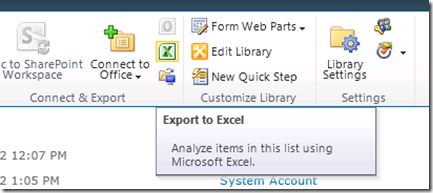How to include/retain the document version with “Export to Excel” (Spreadsheet)
When you have a SharePoint Document Library and use the “"Export to Excel” feature, you may have noticed that document versions will not be exported as expected.
This is the VBA-code created which reads the version-info from your SharePoint-document library and inserts the version-info into your Excel file.
This is the code:
Sub PopulateVersionInfo() reads the version info from the SharePoint
Sub PopulateVersionInfo() inserts the version-info into the Excel-file
Option Explicit
Dim sViewGUID As String
Dim sListGUID As String
Dim sListWeb As String
Dim sarValues() As String
Sub GetCommandText()
Dim sCmdText As String
Dim objDoc As New MSXML2.DOMDocument40
' get the view guid, list guid and url from the Connection object
sCmdText = ActiveWorkbook.Connections(1).OLEDBConnection.CommandText
' Set objDoc = CreateObject("Msxml2.DOMDocument.4.0")
Set objDoc = CreateObject("Msxml2.DOMDocument")
objDoc.LoadXML sCmdText
'' parse out the items we need to make the query
sViewGUID = objDoc.SelectSingleNode("//*/VIEWGUID").Text
sListGUID = objDoc.SelectSingleNode("//*/LISTNAME").Text
sListWeb = objDoc.SelectSingleNode("//*/LISTWEB").Text
Set objDoc = Nothing
End Sub
Sub GetVersionInfoFromSP()
Dim objDoc
Dim objHTTP
Dim sGet As String
Dim viewNodes
Dim i As Integer
'' get the data connection info
GetCommandText
'' we add dummy param dt and set it to the current date/time so
'' the result will not be cached.
sGet = sListWeb & "/owssvr.dll?Cmd=Display&List=" _
& sListGUID & "&View=" & sViewGUID & "&XMLDATA=TRUE&dt=" & Now
Set objDoc = CreateObject("Msxml2.DOMDocument")
Set objHTTP = CreateObject("Msxml2.XMLHTTP")
objHTTP.Open "GET", sGet, False
'' make the call and get the response from the server
objHTTP.send
Set objDoc = objHTTP.responseXML
objDoc.setProperty "SelectionLanguage", "XPath"
Set viewNodes = objDoc.DocumentElement.SelectNodes("//*/*/@ows__UIVersionString")
''get the version information
ReDim sarValues(1 To viewNodes.Length, 1 To 1)
For i = 1 To viewNodes.Length
sarValues(i, 1) = viewNodes.Item(i - 1).Value
Next
Set objHTTP = Nothing
Set objDoc = Nothing
End Sub
Sub PopulateVersionInfo()
Dim lcVersionColumn As ListColumn
'' get the version information
GetVersionInfoFromSP
''add the column and populate
Set lcVersionColumn = ActiveSheet.ListObjects(1).ListColumns.Add
lcVersionColumn.DataBodyRange.Select
lcVersionColumn.Range.Cells(1, 1).Value2 = "Version"
lcVersionColumn.DataBodyRange = sarValues
End Sub
In your Excel file with the connection to your SharePoint Document Library, first run the " Sub GetVersionInfoFromSP()". The version-info from the SharePoint Document Library will be read into an array. Secondly, run the " Sub PopulateVersionInfo()". This code will insert the version-info into your Excel file.
One important note: we are creating some objects from external classes here; Msxml2. The code will fail if msxml2 is not available on the system.
If you receive a compile error in the line:
Dim objDOC As New MSXML2.DOMDocument40
Then the following registry keys may not exist on your machine which are required to fulfill the request.
-> [HKEY_CLASSES_ROOT\Msxml2.DOMDocument.4.0]
-> [HKEY_CLASSES_ROOT\Msxml2.DOMDocument.4.0\CLSID]
-> [HKEY_CLASSES_ROOT\Msxml2.DOMDocument.4.0\CLSID\(Default) = {88D969C0-F192-11D4-A65F-0040963251E5}]
In this case, please download and install the MSXML 4.0 pack from the following source:
https://www.microsoft.com/downloads/en/details.aspx?FamilyID=7f6c0cb4-7a5e-4790-a7cf-9e139e6819c0
If these registry keys do exist and/or MSXML4.0 has been installed already, it’s most likely that reference to the MSXML.DLL is missing. In order to fix this, go in the VBA-editor, point to TOOLS -> REFERENCES and add a reference to "Microsoft XML, v.4.0".
If for some reason the problem still occurs and Excel still has problems to reference the XML-library, use LateBinding instead of EarlyBinding. This might be even a better solution since different machines could have different versions of MSXML.
To do this replace the code line:
Dim objDoc As New MSXML2.DOMDocument40
With:
Dim objDoc
Please make sure to first test this carefully in your test environment. This code is “as-is” and we do not provide support on this custom code.
Happy Exporting ![]()
Thanks to Ina from the Office Team.
